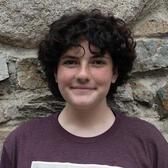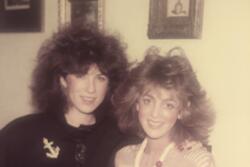L’dor V’dor: How Ritual Plays into Grief
As long as we live, they too will live; for they are now are a part of us; as we remember them. - Poem, “We Remember Them,” by Sylvan Kamens and Rabbi Jack Riemer
What do you say to someone who’s about to die? I understand that every interaction we have could fall under this category; but I’m talking about imminent, soul-crushing death that breathes down your neck and slips in under the crack in the door. Death that is followed by ritual, which is to say, by action. Though Judaism has an endless supply of prayers at the ready for each aspect of death and mourning (like we do for seemingly all things), in my experience, religious emphasis is placed on the living. Judaism doesn’t have a defined afterlife. The Torah and other Talmudic texts speculate that the Jewish afterlife is composed of a heaven and hell of sorts, but these are concepts that aren’t commonly integrated into most modern Jewish settings. Yet through the lens of death, I am able to observe how Jewish ritual transcends written law and davening, and understand what it really means to grieve and to pray.
My family has very specific superstitions and customs that we integrate into death ceremonies. Sharing memories of loved ones with my mom, specifically, is a ritual that we have maintained since my grandma’s death two years ago. I still tell my mother when I dream about her. I still tell her all the things I remember about her, and all the things I never knew. I share the memories of Disneyland trips, Chinese food, LA freeways, and Sunday Skypes. I share the things I’ve just recently learned about her political activism, AIDS walks, and mistakes. This is what makes my grandma whole in my mind. This is what is real about her. Even though it’s been a while, she still visits me every year in my dreams, right around my birthday. Just to say hello.
For many, none of this has anything to do with the preconceived notions they have of Judaism and the Jewish grieving process. But for me and my family, this is how we express grief and how we cope with loss. Still, we find this spiritual connection is enhanced when grounded in Jewish tradition.
One of the simplest metaphors for life is the Yahrzeit candle. It is a small white candle, usually placed in a cheaply made aluminum holder. It can be found in the kosher section of most grocery stores. It is still and it is patient. It sits on a green shelf in my house, waiting. Despite its grim connotation, I am comforted by its presence, knowing that the candle is only meant to burn for a day. Then it too dies.
The first time I remember using a Yahrzeit candle was for my mom’s cat, which seems a little odd if you aren’t an animal person. Lolita was an old cat and loved the rain. She appeared on my mom’s doorstep eighteen years ago. I’d like to think Lolita knew she was going to die before we did, but that’s asking a lot of a cat. The next candle was for my mom’s friend. She was forty-something, had brain cancer and a son a little younger than I. My mom met her at a Jewish summer camp; I met her over brunch in Maryland thirty years later. She died five months after I met her. Another candle was for our beloved family dog, Papaya. We cried, ate, and laughed– even after I vomited out of sheer grief (and probably a little too much brisket as well). This is how we grieve: crying, laughing, brisket and Yahrzeit candles. Again and again and again. Grieving, living, grieving, living.
It was always my mom who initiated this candle-lighting ceremony. Though she never had a Bat Mitzvah and doesn’t know a word of Hebrew, to her, death is a time for Jewish ritual and reflection. My mother wasn’t raised Jewish in the way I am. I am Big Jewish in a Small Town: living in Albuquerque, a majority Catholic city. She is Small Jewish in a Big Town: growing up in Baltimore, a city with a thriving Jewish community. For my mom, to be Jewish is to act, and to act is to set aside intention towards Jewish thought. Her ritual is not prayer, is not ripping clothes, is not saying the Mourner’s Kaddish. It is superstition, anecdotes, gathering, and sharing. So that’s what we do. And it starts with something as simple as lighting a candle.
Living in our own tiny diaspora, coming together as an extended family is a rare occurrence, and true to Jewish legend, one that usually only happens at weddings and funerals. And when we do finally see each other, it's a tidal wave of gossip and noshing. Celebrating life and death in tiny tide pools of nostalgia.
“I remember…”
“Did you hear?”
“Oh, don’t even get me started…”
This is exactly what happened at my Grandma’s funeral, which she planned herself. I’m sure there’s a joke in there somewhere. Her theme colors were to be white and purple. Her caterer of choice was Panera Bread. She knew, she prepared, she passed. We lit the Yahrzeit candle from the green shelf that night.
Lighting a Yahrzeit candle might commemorate death when it is staring you directly in the face, but what about in everyday life? These new memories, this shared grief, is what leads me to believe that mourning doesn’t have to be based on Jewish liturgical practice for it to be considered Jewish. Prayer is too broad of a term to apply only to a small section of piety. Grief and prayer are not solutions to the other: they are ways of deriving raw emotion from the human psyche and translating it into something that can be shared and mutually understood.
As I crawl towards adulthood, the rituals associated with death begin to unravel a little more clearly in my mind. All of these traditions, these quirky customs that my family has made and shared have helped me to understand –even challenge– my ideas surrounding death: from funerals to dreams, from writing letters to saying Mourner’s Kaddish, from generation to generation—L’dor V’dor.
This piece was written as part of JWA’s Rising Voices Fellowship.








This writing was so helpful to me, as my husband of over 54 years has advanced Alzheimers and is in a nursing home. It is very hard for me to imagine living without him, even though I understand the illness and know it is going to happen sooner than I would hope. Our wonderful rabbi and special temple no longer exist, but it brought the memory of the Hymn, L’ V’ dor to my mind! Your piece also reminded me of something my mother always said, “Life is for the living!” This also reminds me to take care of myself, the caregiver, as my children and family keep telling me. Thank you for a beautifully written piece. I'm so glad I had the opportunity to read it.
Very thoughtful, profound & moving. I am very glad I got to read this. It provides a sound & meaningful perspective that resonates with me, As I think it would with many people if they were to read it. I think Big Jewish is a very bright and perceptive person who is a lot closer to being an adult than she thinks and maybe more of an adult than many much older people are. Well done!
This is such a wonderful perspective and very well/written! Love it!
Very thoughtful work. Excellent.